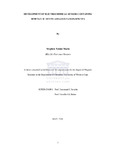| dc.contributor.author | Mailu, Stephen Nzioki | |
| dc.date.accessioned | 2019-04-04T06:30:53Z | |
| dc.date.available | 2019-04-04T06:30:53Z | |
| dc.date.issued | 2010 | |
| dc.identifier.uri | http://ir.mksu.ac.ke/handle/123456780/4230 | |
| dc.description.abstract | Polyaromatic hydrocarbons (PAHs) are ubiquitous environmental pollutants that have
been shown to be teratogenic, mutagenic and carcinogenic and pose serious threats to
the health of aquatic and human life. Several methods have been developed for their
determination such as immunoassay, gas chromatography and high performance
liquid chromatography (HPLC) in combination with fluorescence or absorbance
detection. However, these methods are known to manifest underlying disadvantages
such as complicated pretreatment, high costs and time consuming processes. In this
work, a simple, less time consuming electrochemical method in the form of an
electrochemical sensor has been developed for the detection of PAHs. The sensor was
fabricated by the deposition of silver-gold (1:3) alloy nanoparticles (Ag-AuNPs) on
ultrathin overoxidized polypyrrole (PPyox) film which formed a PPyox/Ag-AuNPs
composite on glassy carbon electrode (PPyox/Ag-AuNPs/GCE). The silver-gold alloy
nanoparticles deposited to form the composite were chemically prepared by
simultaneous reduction of silver nitrate (AgNO3) and chloroauric acid (HAuCl4) using
sodium citrate and characterized by UV-visible spectroscopy technique which
confirmed the homogeneous formation of the alloy nanoparticles. Transmission
electron microscopy showed that the synthesized nanoparticles were in the range of
20-50 nm. The properties of the composite formed upon deposition of the
nanoparticles on the PPyox film were investigated by electrochemical methods. The
PPyox/Ag-AuNPs/GCE sensor showed strong catalytic activity towards the oxidation
of anthracene, phenanthrene and pyrene, and was able to simultaneously detect
anthracene and phenanthrene in a binary mixture of the two. The catalytic peak
currents obtained from square wave voltammetry increased linearly with anthracene,
phenanthrene and pyrene concentrations in the range of 3.0 x 10-6 to 3.56 x 10-4 M,
iv
3.3 x 10-5 to 2.83 x 10-4 M, 3.3 x 10-5 to 1.66 x 10-4 M and with detection limits of
0.169 µM, 1.59 µM and 2.70 µM, respectively. The PPyox/Ag-AuNPs/GCE sensor is
simple, has antifouling properties and is less time consuming with a response time of
4 s. | en_US |
| dc.language.iso | en_US | en_US |
| dc.subject | Polyaromatic hydrocarbons (PAHs) | en_US |
| dc.subject | Electrochemical sensor | en_US |
| dc.subject | Overoxidized-polypyrrole composite (PPyox) | en_US |
| dc.subject | Silver-gold bimetallic alloy nanoparticles (Ag-AuNPs) | en_US |
| dc.subject | Polypyrrole polymer (PPy) | en_US |
| dc.subject | Anthracene (AN) | en_US |
| dc.subject | Pyrene (Py) | en_US |
| dc.subject | Phenanthrene (PHE) | en_US |
| dc.subject | Cyclic voltammetry (CV) | en_US |
| dc.subject | Square wave voltammetry (SWV) | en_US |
| dc.subject | Electrochemical impedance spectroscopy (EIS) | en_US |
| dc.subject | Bimetallic nanoparticles | en_US |
| dc.title | Development of electrochemical sensors containing bimerallic silver and gold nanoparticles | en_US |
| dc.type | Thesis | en_US |

